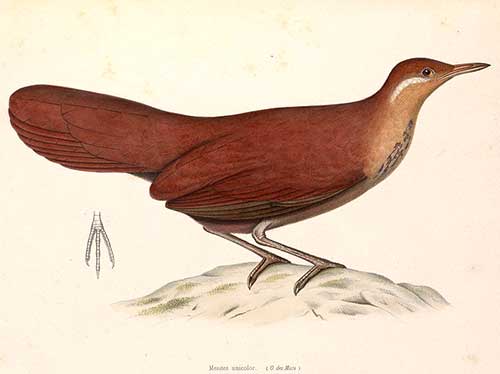
Fr: Mesite unicolore
Ang: Brown Mesite
All: Einfarb-Stelzenralle
Esp: Mesito Unicolor
Ita: Mesite bruno
Nd: Bruine Steltral
Sd: brun mesit
Mal: manganahitra, Roatelo, Vorona atambo, Vorona atmbo
Photographer:
Dubi Shapiro
Dubi Shapiro Photo Galleries & Dubi Shapiro's Pictures on IBC
Illustrator :
Marc Athanase Parfait Œillet Des Murs (1804-1878)
Origine de l’illustration (1849)
Text by Nicole Bouglouan
Sources:
HANDBOOK OF THE BIRDS OF THE WORLD Vol 3 by Josep del Hoyo-Andrew Elliott-Jordi Sargatal - Lynx Edicions - ISBN: 8487334202
Birds of Madagascar: A Photographic Guide Par Pete Morris, Frank Hawkins – ISBN: 0300077556, 9780300077551- Editeur: Yale University Press, 1998
The Birds of Africa: Volume VIII: The Malagasy Region: Madagascar, Seychelles, Comoros, Mascarenes - Par Roger Safford, Frank Hawkins – ISBN: 1408190494, 9781408190494- Editeur: A&C Black, 2013
Creagus – Don Roberson - MESITES Mesitornithidae
Wikipedia, the free encyclopaedia
Brown Mesite
Mesitornis unicolor
Mesitornithiformes Order – Mesitornithidae Family
INTRODUCTION:
The Brown Mesite is endemic to Madagascar where it frequents the humid forest in the east. It forages by walking on the forest floor where its brown plumage makes it almost invisible on the leaf litter. It feeds on insects and seeds. It is territorial and secretive.
This species breeds during the rainy season, and the nest is usually low, 1-2 metres above the ground.
The Brown Mesite is patchily distributed in the eastern rainforest, but the forest is continuously degraded and destroyed for agriculture expansion and logging. It is hunted in some areas, and preyed upon by dogs and introduced rats, as this bird rarely flies. It is currently listed as Vulnerable.
DESCRIPTION OF THE BIRD:
Biometrics:
Length: 30 cm
Weight of one female: 148 g
The Brown Mesite has rufous-brown upperparts, but lower mantle, scapulars and the area from back to uppertail-coverts are bright chestnut. The tail is dark chestnut. On the upperwings, the flight-feathers, the primary coverts and the alula are grey-brown with chestnut edges. The other wing-coverts are bright chestnut.
On the underparts, chin and throat are cinnamon-buff. We can see a white streak behind the eye, varying in extent and intensity. It usually extends to the upperside of the neck. The upper breast is cinnamon-buff with some scaly pattern due to darker feather edges. Centre of lower breast and belly are cinnamon-buff with dark mottling. Flanks, breast sides and sides of belly are grey-brown with rufous tinge. The undertail-coverts are dark grey-brown and have rufous tips. The underwing is greyish-brown.

On the head, the crown is rufous-brown but darker than upperparts, with blackish tinge on sides of crown and nape. The hindneck is rufous-brown. Lores, ear-coverts, cheeks and lower sides of neck are cinnamon-brown, but the last two are brighter.
The straight bill is dark brown with slightly paler lower mandible and dark yellow base. The eyes are brown. Legs and feet are greenish-brown.
Male and female are similar.
The juvenile is cinnamon-brown overall with darker upperparts. It has blue or whitish skin around and behind the eye.
RANGE:
The Brown Mesite is found in E Madagascar, from Tôlagnaro (Fort Dauphin) to Marojejy.
HABITAT:
The Brown Mesite frequents undisturbed primary evergreen rainforest where it occurs in dark areas with thick leaf litter. It is visible from sea-level up to 1,200 metres of elevation, but it is more often seen between 700 and 900 metres in areas with steep slopes and sparse grassy cover.
CALLS AND SONGS: SOUNDS BY XENO-CANTO
The Brown Mesite’s contact call is a low “kssst” or “crrrt”. When the bird is threatened, it produces hissing and clucking alarm notes.
The song is a long series of phrases “piew…piew…piew… piewpiewpiew” or “crucrucrucru cru cru criew criew”. The short, rapid notes are repeated several times, and are followed by repeated single notes.
The Brown Mesite is more vocal in the early morning around sunrise. The song is initially delivered from the roost site. It can be heard sometimes during the rest of the morning, but never in the afternoon.
BEHAVIOUR IN THE WILD:
The Brown Mesite feeds mainly on invertebrates such as insects (cockroaches, beetles and ants), spiders and gastropods. It also consumes seeds.
It forages by walking slowly and investigating quietly a suitable area. The foraging techniques are similar to those of the White-breasted Mesite. It gleans from leaves at ground-level.
The Brown Mesite is usually found alone or in small family groups. The Malagasy name of the species is “Roatelo” that means “two-three” referring to the small groups of 2-3 individuals, the pair and one young, formed by this mesite.
It is probably monogamous and breeds during the rainy season.

The Brown Mesite may perform altitudinal movements (Masaola) with birds commonly found at lower elevation during the local winter.
This species flies rarely and only to escape predators or to avoid obstacles, and usually over short distances.
REPRODUCTION OF THIS SPECIES:
The breeding season occurs during the rainy season in late November/December, with the laying in October/December.
The nest of the Brown Mesite is a platform made with twigs and thin sticks, and lined with some leaves, grass and moss. It is placed in the fork of a sloping tree, 1-2 metres above the ground, allowing the bird to reach it without flying.
Only two nests were found, each containing a single whitish egg with some dark markings at one end. The eggs appear disproportionally large, compared to the size of the bird, but currently, there is no explanation. The clutch is possibly larger like in other mesites.
The incubation appears to be mainly done by the female, but the role of the male is unknown. The chick is rufous-buff with pale eyering of bare skin. It leaves the nest very soon, when still downy.
PROTECTION / THREATS / STATUS:
The Brown Mesite is threatened by habitat loss through slash-and-burn cultivation and commercial timber exploitation. The species is hunted in some areas. Dogs and introduced rats (Rattus rattus) are important predators near villages.
The population is roughly estimated to number 3,500/15,000 individuals and is declining rapidly.
The Brown Mesite is currently listed as Vulnerable.